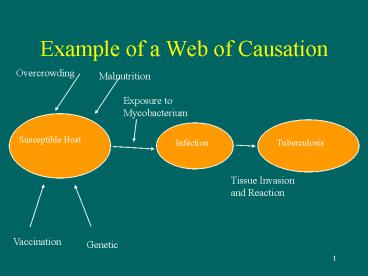Example of a Web of Causation - PowerPoint PPT Presentation
1 / 22
Title:
Example of a Web of Causation
Description:
Saliva on solids and liquids (fomites) Saliva direct to new host ... Exposure to causative agent: no symptoms present. Clinical Stage: Symptoms present ... – PowerPoint PPT presentation
Number of Views:1796
Avg rating:3.0/5.0
Title: Example of a Web of Causation
1
Example of a Web of Causation
Overcrowding
Malnutrition
Exposure to Mycobacterium
Susceptible Host
Infection
Tuberculosis
Tissue Invasion and Reaction
Vaccination
Genetic
2
Roles of hosts
- Maintenance host
- maintains infection within endemic area
- Secondary host
- Amplifier host
- increases disease risk
- pigs and Japanese B encephalitis
- Incidental
- Vector
3
Exit routes - mouth and nose
- Saliva on solids and liquids (fomites)
- Saliva direct to new host
- Excessive nasal/salivary secretion
- Lacrimal
- Faeces on solids and liquids
- Aerosolised faeces in dust
- Vomitus
4
Exit routes - urogenital
- Organism established in urinary tract
- leptospirosis
- splash droplets
- meat works
- Semen
- Ova (Salmonella enteritidis)
- Venereal
- organisms often not resilient in environment
- Treponema pallidum (syphilis)
- Neisseria gonorrhoeae
5
Exit routes - skin and hair
- Direct contact - skin and hair
- Lice, mites
- Skin detritus, scabs
- Pox viruses
- Herpes simplex
- Vector-borne transfer
- Malaria
- Secondary skin contamination
6
Exit routes - products
- Milk - Bovine TB, brucellosis
- Meat/offal
- Cadavers, products of disease processes
- effusions, discharges from lesions e.g. draining
abscesses - anthrax, clostridiosis (gaseous oedema)
7
Routes of Entry
- Mouth and nose
- airborne
- food, water contaminated with agent
- Skin and hair
- Injury to skin or membranes
- AIDS, rabies leptospirosis
8
Agent - host relationship
Agent
Habitat where agent survives or propagates
Reservoir
Mode of transmission
Many diseases have multiple reservoirs and modes
of transmission
Host
9
Natural History of Disease
- The process by which diseases occur and progress
in humans
10
Natural History of Disease
Exposure to Agent
Symptom Development
Pre-exposure Stage Factors present leading to
problem development
Preclinical Stage Exposure to causative agent
no symptoms present
Clinical Stage Symptoms present
Resolution Stage Problem resolved. Returned to
health or chronic state or death
Primary Prevention
Secondary Prevention
Tertiary Prevention
11
Typical course of infectious disease
TIME
Subclinical Disease
Death
Susceptible Host
Clinical Disease
No infection
Recovery
Incubation period
Exposure
Onset
12
Induction latency incubation
TIME
Susceptible Host
Subclinical Disease
Clinical Disease
Induction
Latency
Incubation
Clinical onset
Exposure
Disease onset
13
Latency and infectiousness
TIME
Susceptible Host
Subclinical Disease
Clinical Disease
Death Recovery
Latent
Non-infectious
Infectious
Incubation
Infection
Clinical onset
14
Transmission Mechanisms
15
Iceberg concept of infectious disease in
populations
DEATH
CLINICALDISEASE
SEVEREDISEASE
SUB CLINICALDISEASE
MILD ILLNESS
INFECTION WITHOUT CLINICAL ILLNESS
EXPOSURE WITHOUT INFECTION
16
Endemic Disease
- Disease present in population or region at all
times - Usually low and predictable level
- Enzootic used for some animal diseases
17
Seaonality of disease Human leptospirosis in
U.S.A
18
Sporadic Disease
- Infrequent disease occurrence
- Irregular and unpredictable
19
Epidemic Disease
- Incidence exceeds expected
- Usually infectious disease or poisoning
- In animals, occasionally referred as epizootic
disease - Point source or propagated
20
Point Epidemic
- Single common exposure
- Does not spread
- Foodborne disease outbreaks
21
Propagated Epidemic
- Spread between animals
- Often involves vectors or carriers
22
Summary
- Simple description of disease occurrence is the
first step in epidemiological investigations - Disease patterns































